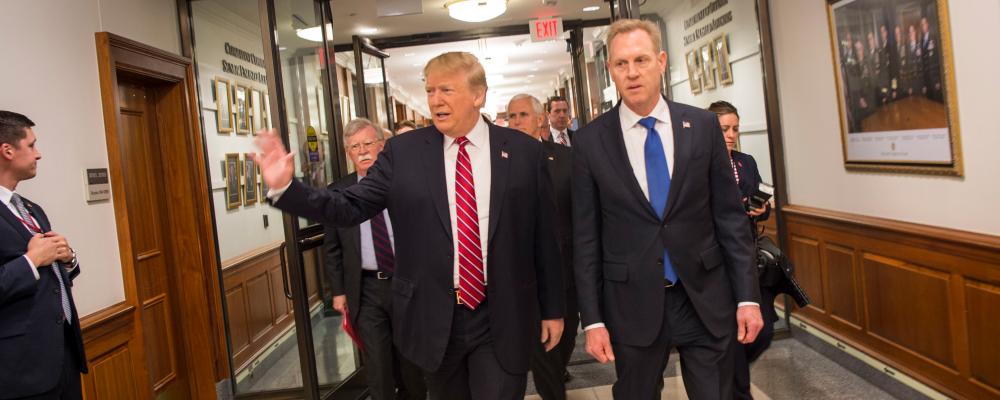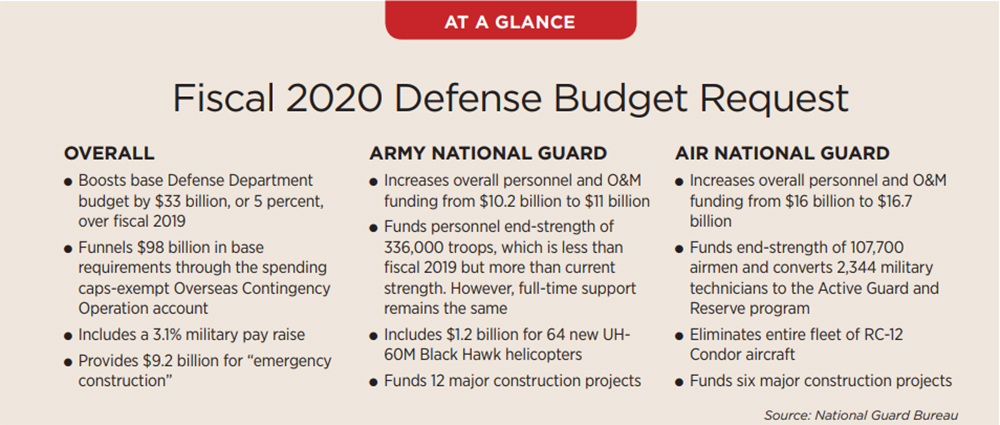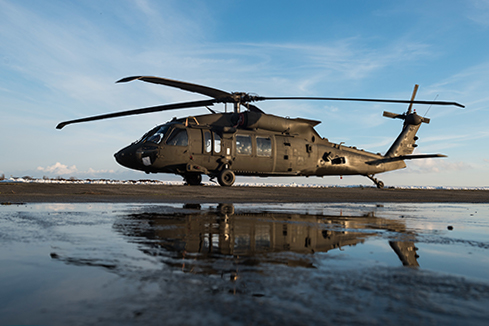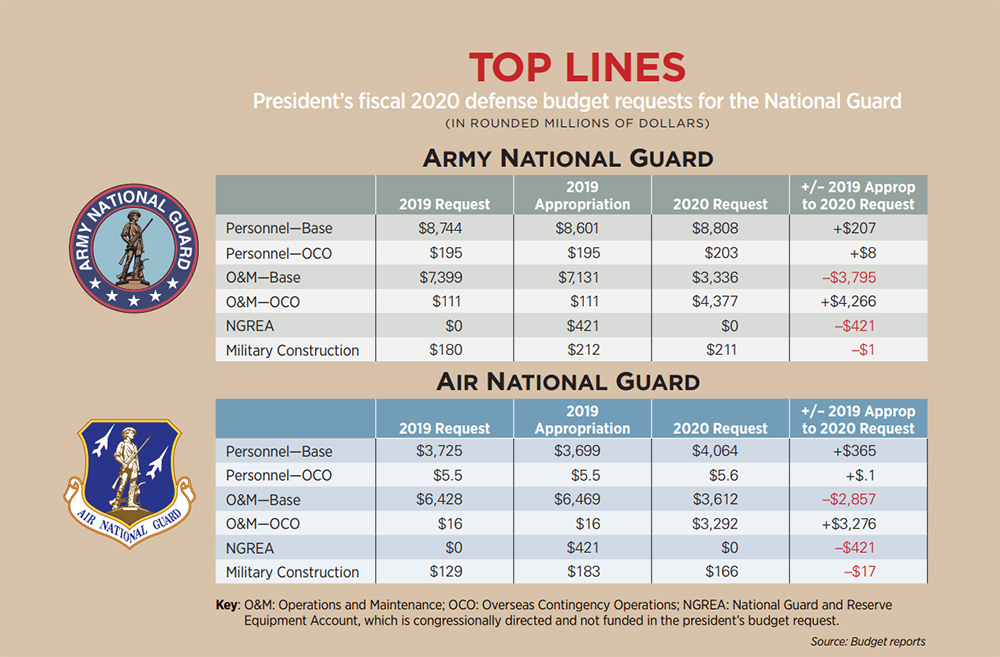
There is a lot for the National Guard to be happy about in President Donald Trump’s fiscal 2020 defense budget request.
The spending proposal would increase funds for the Army and Air National Guard in both the personnel and readiness accounts. It also adds troops and includes a hefty pay raise for uniformed personnel. And it contains almost 90 new or completely modernized UH-60 Black Hawk helicopters for the Army Guard.
Sent to Congress last month, the request would provide roughly $718 billion to the Defense Department. This includes nearly $544 billion in base funding and $165 billion for Overseas Contingency Operations. Some $66 billion of the OCO funds would go to warfighting while roughly $98 billion would fund base requirements.
Also in the DoD proposal is more than $9 billion for “emergency construction” to rebuild military facilities damaged by the recent hurricanes and to help fund the wall on the southern border.
Overall defense baseline spending would grow to $576 billion with a defense topline of $750 billion with the request of approximately $32 billion for national security programs performed by the Department of Energy’s nuclear laboratories and other agencies.
The $576 billion figure is the cap on defense spending set by the Budget Control Act of 2011. The White House is using cap-exempt OCO and emergency accounts to reach its topline without having to increase nondefense spending, which it wants to cut. The president and Congress agreed to raise the caps on both for fiscal 2018 and 2019.
“I caution that no adversary can be as damaging to our military readiness
as budgetary instability.”—Acting Defense Secretary Patrick Shanahan
Consequently, this latest proposal has almost no chance of surviving Congress intact. Lawmakers, especially Democrats who control the House, have decried the president’s use of OCO to duck the caps. He said he won’t sign another budget agreement. More on both in a bit.
Operations and maintenance is one place the budget request uses OCO for base requirements. The president increases O&M for both the Army and Air Guard, but much of the money comes through OCO. The Army Guard would climb from $7.25 billion to $7.7 billion while the Air Guard would go from $6.5 billion to $6.9 billion.
Guard pay and allowances (P&A) would also see an increase, but mostly through the base budget.
The Army Guard increases from $8.8 billion to $9 billion. The amount covers a 3.1% pay raise but fewer soldiers. The 336,000 troops requested is about 500 personnel more than are in the force today. Authorized endstrength for fiscal 2019 is 343,000 soldiers. There is no increase for full-time support.
Air Guard P&A increases more than $360 million to $4.1 billion. The boost covers the 3.1% pay raise, 600 more airmen for a total of 107,700 and the conversion of another 2,344 military technicians to the Active Guard and Reserve program. The Air Guard began the conversion program this year.
Spending on military construction was once a significant piece of the Guard’s annual budget. Not anymore. For the Army Guard it is $212 million for 2019 and shrinks to $211 million in the budget request for 2020. That amount would fund a handful of new readiness centers and upgrades to training centers.
The downturn in MILCON comes at an especially bad time. Guard leaders who accessed Army Guard facilities nationwide in recent years and crunched the numbers believe the force
requires more than $1 billion annually for 15 years to move raise collective condition index to “fair.”
Current funding levels have things deteriorating further, the same leaders say.
The Air Guard’s MILCON budget request for 2020 is $166 million, down from $183 million this year. It covers improvements at four bases, including $50 million for improvements to facilities at Muñiz Air National Guard Base, Puerto Rico, which was almost flattened by Hurricane Maria in 2017.

The good news in the budget proposal for the Guard request extends to equipment procurement.
Among the highlights is $1.2 billion for 64 new UH-60M Black Hawks for the Army Guard. That’s 25 more than the number the Army has requested for the Guard in last three budgets combined.
There are also 23 L-to-V-model Black Hawk conversions and 512 Joint Light Tactical Vehicles, with plans to provide more than 3,000 JLTVs to the Guard in the next five years.
The 512 would be enough to outfit one brigade combat team. They would be the Guard’s first JLTVs.
None of the new equipment would reach the force for a couple of years.
But there are no new AH-64E Apache attack helicopters in the request for the Guard.
Congress added six in the fiscal 2019 appropriations and NGAUS is looking for lawmakers to do it again in 2020 budget.

Pierre-Etienne Courtejoie
TFor the Air Guard, the proposal is more about aircraft turnover than procurement. The largest movements would add 16 F-35A Lighting IIs and shed 18 F-16 Fighting Falcons and all 13 RC-26B Condors.
Operated only by the Air Guard, the RC-26B is an intelligence, surveillance and reconnaissance platform used in counterdrug operations. The Air Force says it no longer has a federal mission.
Nevertheless, it has been employed for the ongoing mission on the southern border. It also has a significant champion in Rep. Adam Kinzinger, R-Ill., who flies the aircraft for the Wisconsin Air Guard.
One entry on the Air Force proposed procurement list should be of special interest to the Air Guard. It’s eight F-15X Eagles, the latest variant of the four-decade-old fighter. Air Force officials reportedly didn’t want them, but they are in the request, with many more planned for the future.
They will replace aging F-15s. The Air Guard flies 139 F-15C/Ds across six wings in five states (California, Florida, Louisiana, Massachusetts and two in Oregon). Five of the units are the backbone of the nation’s aerospace control alert system. The sixth is the Air Force’s only F-15 schoolhouse.
The original F-15s first flew in 1972, and many of the Air Force’s current Eagles entered service in the 1980s. The Air Guard F-15s are on average 35 years old. Most have received some upgrades, but many now need very expensive structure and technology fixes to stay in the fight.
The Air Force has not purchased new F-15s since placing a 2001 order for five F-15E Strike Eagles, a two-seat version that can bomb ground targets and shoot down other aircraft.
But Boeing continues to build the aircraft for U.S. allies, such as South Korea, Singapore, Saudi Arabia and Qatar. Advocates say they are cheaper to maintain and easier to convert to than fifth-generation aircraft.
“I think we’re staring down the barrel of a [continuing resolution] September 30.”
—Sen. David Perdue, R-Ga., Senate Armed Services Committee
Published reports in December had the F-15Xs going to the Air Guard, but there has never been an official confirmation and some active-component wings fly the F-15C/D.
The F-15X may face a dogfight. The decision to buy F-15Xs comes as the number of planned F-35 purchases has been trimmed.
Many lawmakers from states where F-35 components are built, including a more than 100-member House Joint Strike Fighter Caucus, oppose the move.And then there’s the annual mystery equipment fund: NGREA, the National Guard and Reserve Equipment Account.
Each year the Defense Department leaves that budget line blank and Congress adds money for it. The money is used to buy required equipment not included in the budget requests. Items may range from aircraft and vehicles to ammunition and weapons. For 2019, lawmakers awarded each Guard component $421 million. It has been as much $500 million each in recent years.
For 2020, that’s anybody’s guess, but Congress is usually generous.
The budget proposal is a nonstarter with House Democrats, who now control what comes out of that chamber. And it’s not the content that troubles them.
“Incredibly disingenuous” is how Rep. Adam Smith, the chairman of the House Armed Services Committee, characterizes the use of OCO to avoid the spending caps.
“That’s not going to happen,” Smith said in late March. “It’s the wrong way to budget. OCO has always been a little fudgey in terms of using it to fund some things that might not necessarily have been part of the overseas contingency operation. But now, they’ve eliminated any pretense.”
Defense dollars for the border wall is another sticking point. The 35-day partial government shutdown over the wall funding is still fresh in many minds on Capitol Hill. The matter never was resolved, and the president moved forward on funding the wall via a national emergency declaration.
House and Senate leaders have spoken about another two-year budget agreement that would raise the spending caps for both defense and domestic spending in fiscal 2020 and 2021. The topline number mentioned most for defense in 2020 is $733 billion. That would require a $17 billion cut from what the president proposed, but $733 billion was his original defense topline last fall.
But any agreement to loosen the caps would require the president’s signature, which appears very unlikely. The White House is concerned about the practical and political consequences of the increasing budget deficits. They’ve grown in his administration. Last fall, the U.S. Treasury put the nation’s fiscal 2018 budget deficit at $779 billion, the most in six years. And the red ink could reach $1 trillion in fiscal 2019.
Put it all together and the prospects of an on-time budget look bleak.
“I think we’re staring down the barrel of a [continuing resolution] September 30,” said Sen. David Perdue, R-Ga., at an April 4 hearing of the Senate Armed Services Committee.
A CR would normally mean funding the government at the previous year’s spending levels and no new programs. That’s bad enough, but things would be worse to begin fiscal 2020. The spending level would be in accordance with the mandated caps, better known as sequestration, which would reduce defense spending from 2019 to 2020 by as much as $100 billion.
It would be on an “absolutely devastating scope and scale,” outgoing Air Force Secretary Heather Wilson told senators at the April 4 SASC hearing. “Sequester at this point would be four times as bad as it was in the previous time that the Air Force went through it,” she said, estimating the Air Force budget would take a $29 billion hit.
That would trigger a horror show of consequences, she said.
“So let me give you what that would look like,” Wilson said. “No F-35s, cut all of the KC-46s, stop the B-21 program, no ground-based strategic deterrent, no research development tests and evaluation for any space system, most of the fourth- and fifth-generation modifications, and all the science and technology … 16 new military construction projects that wouldn’t start.”
The same could be said for the positives for the Guard in the budget request.
Acting Defense Secretary Patrick Shanahan put the issue another way during a March 14 SASC hearing.
“I caution that no adversary can be as damaging to our military readiness as budgetary instability,” he said.
Lawmakers return from their two-week Easter recess April 29 with a challenge. The Senate has 61 working days and House has 45 days until the August recess. That appears to be the window to avoid staring down the barrel of the gun.

